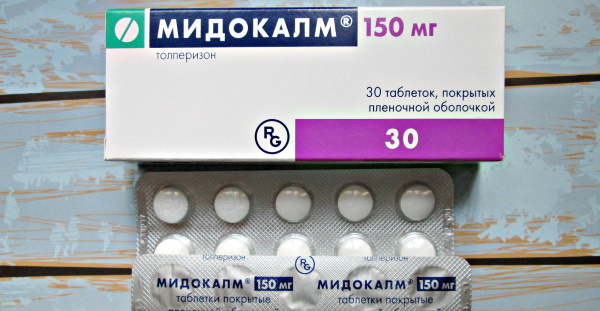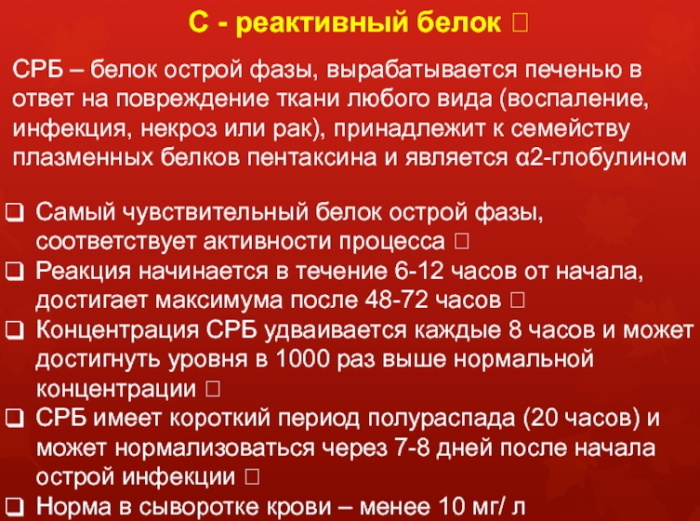Content
- Transient causes of pain in the back of the head and neck
- Causes of pain associated with diseases of the spine
- Vascular disease
- Brain Diseases
- Facet joint dysfunction
- Other reasons
- Differentiation of the most common causes by the nature of the pain
- Differential diagnosis by instrumental and laboratory methods
- Treatment methods
- Physiotherapy for stress
- With osteochondrosis of the cervical spine
- Neck Pain Video
Neck and nape pain have different causes.: from fatigue and overstrain, to brain diseases. It is impossible to distinguish a serious illness from overwork on your own. Even if the pain is passing, but occurs more often than once a week, you need to do an MRI of the head and neck. This is the only way to establish an accurate diagnosis with just one examination.
Transient causes of pain in the back of the head and neck
Neck pain, radiating to the back of the head, often occurs due to muscle tension after being in a sitting position, when the head is slightly tilted for a long time. Fatigue syndrome often develops in office workers, salespeople, and drivers, since people in these professions are forced to spend all their working hours in the same position.
Fatigue of the muscles leads to an increase in intracranial pressure, which entails the spread of pain to the temples, forehead, and eyeballs.
Pain also often occurs against a background of high mental stress:
- stress;
- anxiety;
- depression.
A stressed person may also feel nauseous and dizzy.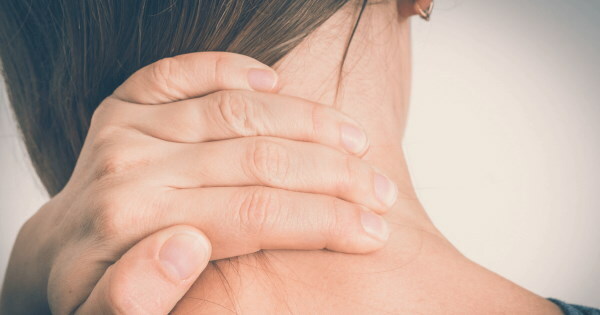
Mental stress negatively affects the cardiovascular system. The state of stress forces one to take uncomfortable body postures, when a person subconsciously tries to close himself off from the environment, to become invisible. In this case, he begins to slouch, raise his shoulders, as if drawing in his neck. Such actions only exacerbate the tension of the neck muscles. Over time, chronic pain syndrome develops and only a few can get out of the state of constant stress without medication.
If, against the background of tension in the muscles of the neck, a person has diseases of the spine, there is a high probability of pinching the nerve due to compression of its roots. As a result, the pain becomes stronger, it can persist from 2-3 days to 1-2 weeks.
To relax, you need to take a weekly course of taking sedatives, connect a light neck exercise, go through 2-3 massage sessions. If the pain is not constant, you can take a warm bath to relieve tension.
Causes of pain associated with diseases of the spine
Soreness that does not go away for a long time can appear in the back of the head and neck with any diseases of the spine. Often, discomfort appears due to compression of the nerve endings that run along the spinal column. Back diseases often develop together, or one pathology becomes the cause of the development of another: due to curvature of the spine or osteochondrosis, neuralgia begins, a hernia forms.
The main causes of pain:
-
Osteochondrosis. The disease is characterized by destruction of the vertebrae that support the neck. In addition to pain in the back of the head, discomfort in the temples may be felt. The disease is often accompanied by noise or ringing in the ears, problems in the functioning of the vestibular apparatus, and nausea.

- Occipital neuralgia. Pathology develops as a consequence of other problems with the spine. Nerve endings can become inflamed due to exposure to cold, draft. The person experiences shooting pain in the neck, affecting the occipital region, with any movement of the head. With complete relaxation and freezing in one position, the pain subsides, other symptoms do not develop.
- Spondylosis. The disease is characterized by overgrowth of bone tissue on the vertebrae. If growths form in the neck, a person feels a dull pain when moving his head and at rest. With stress, the soreness increases. The growths compress the vessels, which leads to the development of diseases of the circulatory system.
Vertebrobasilar syndrome can be a consequence of osteochondrosis of the cervical spine. In addition to pain in the cervico-occipital region, it causes tinnitus, the appearance of a "veil" in front of the eyes and double vision. With an exacerbation of the condition, nausea and vomiting occur, hiccups are possible.
The skin turns pale, there is a violation of sound perception, coordination is impaired. A diagnostic symptom of pathology is a sudden fall and immobility of a person who is conscious. This can happen when turning or suddenly throwing the head back.
Persistent pain syndrome, which is aggravated at rest, may indicate a lesion of the vertebrae with metastases. The condition is accompanied by fever, general loss of strength, increased sweating. When pressing on the spinous processes, local pain occurs.
A neurologist deals with the treatment of pathologies of the spine.
Vascular disease
Pain in the neck and back of the head, the causes of which lie in impaired blood circulation, can cause diseases:
- Hypertension. High blood pressure always causes headaches and muscle tension at the base of the skull. The condition may be accompanied by double vision and dizziness.
- Crampingvessels. The condition causes a throbbing in the back of the head, which radiates pain to the temples and the back of the head. When the neck moves, the discomfort increases.
- High intracranial pressure. In addition to severe pressing pain, hypertension causes loss of strength, nausea and dizziness. If the pressure is not lowered in time, hallucinations and seizures may occur.
-
Stroke. With a blockage by a plaque or a rupture of a cerebral vessel, an attack of acute head and neck pain develops. Partial paralysis is possible. A person loses the ability to distinguish between the surrounding space, his speech becomes slurred.
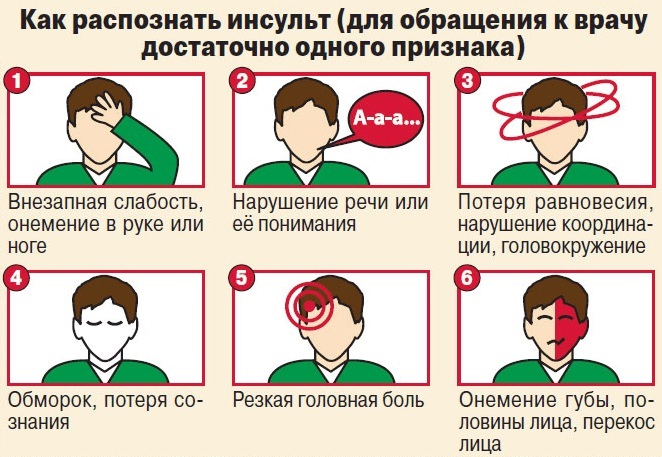
Harbingers of stroke in women and men
Each of the causes requires treatment immediately after the development of the condition.
Brain Diseases
Pain in the neck and back of the head, the causes of which have not been established after an examination of the spine, can be caused by brain diseases:
- Concussion as a result of bruising, falling. The pain occurs due to an increase in intracranial pressure due to the formation of internal hematomas.
- Neoplasms. Tumors compress the surrounding tissues, which can cause pain in the back of the head and neck if the formation is located in this area.
A neurologist can rule out brain diseases. For diagnosis, use the method of MRI or CT, conduct angiography of the vessels.
Facet joint dysfunction
The facet joint is the place of articulation of the articular processes of the vertebrae. The bone structures that form them are covered with cartilaginous tissue, and the joint itself is closed by a small synovial bag, which contains joint fluid.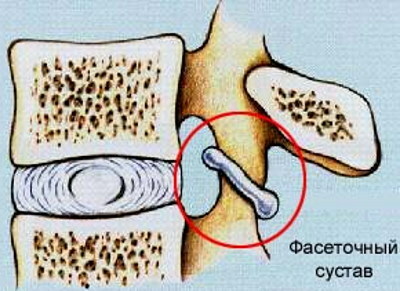
The defeat of the structure of the facet joints is one of the most common causes of pain, which accounts for about 80% of all cases of treatment of patients with pain in the neck and occiput. Thinning of cartilaginous tissue is accompanied by the formation of bone growths - osteophytes. They narrow the lumen of the holes between the vertebrae, squeeze the nerve endings.
Pathology is accompanied by dull, but prolonged pain. The syndrome gets worse over the course of the day. Pain can occur immediately after sleep if a person has been lying in an uncomfortable position for a long time, on a high pillow, sleeping on his stomach. When moving, the pain intensifies, radiates to the ear, temple, shoulder.
Other reasons
Pain in the back of the head and neck from behind can provoke diseases indirectly related to the localization of unpleasant sensations:
| Affected systems | Causes |
| Diseases of the ENT organs | Angina, pharyngitis, inflammation in the nasopharynx and auditory canals. |
| Diseases of the teeth | Deep caries, abnormal growth of wisdom teeth, periodontal disease. |
| Pathology of the visual organs | Cataract, scleritis, conjunctivitis. |
Often, a combination of pain in the neck and back of the head is a manifestation of a migraine. Up to 75% of patients with a migraine attack are the first to notice the development of neck pain. This leads to the common misconception that neck discomfort is the cause of headaches. In fact, the opposite is true.
Pain in the neck and back of the head, the causes of which are in the defeat of the body by infectious diseases, rarely develops. But the likelihood of the spread of nonspecific or tuberculous spondylitis, epidural abscess is not excluded.
Rheumatoid arthritis can also be a possible cause of pain in the cervico-occipital region. Pain syndrome can spread to the forehead and eye sockets. The pain becomes worse when turning and tilting the head, the skin on the neck and shoulders loses sensitivity.
The diagnosis of secondary factors causing pain is performed by general practitioners after other possible causes have been ruled out by highly specialized specialists.
Differentiation of the most common causes by the nature of the pain
Pain in the neck and back of the head, the causes of which do not belong to specific and rare diseases, can suggest which factor caused its development:
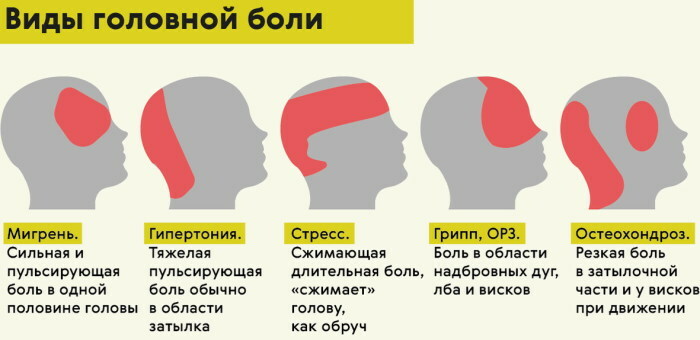
| Hypertension | The pain syndrome only intensifies with time, the pain is pulsating and constant, there is a feeling of head distention. |
| Vascular diseases | Vascular problems are accompanied by throbbing pain. An attack begins from the back of the head, gradually spreading first to the crown of the head, and then to the forehead. |
| Nervous tension | The pain can be of different intensity, it goes away on its own after 5-6 hours. The appearance of discomfort is always preceded by a stressful situation. |
| Overwork | Soreness occurs after prolonged mental or physical work, when a person has been in an uncomfortable position for a long time. The pain is dull, prolonged. |
| Spondylosis | The condition is characterized by prolonged, often persistent pain in the neck and back of the head. In advanced cases, it radiates to the eyes and ears. |
| Occipital neuralgia | The condition is characterized by frequent recurrent pain in the back of the head and neck. It spreads to the temporal region, to the ear. The sensation intensifies when coughing and sneezing, turning the neck. |
| Migraine | The condition causes throbbing pain in the region of the crown, occiput. The syndrome affects one half of the head. |
Differential diagnosis by instrumental and laboratory methods
To make a diagnosis, you need the results of at least 2 examinations. Comprehensive diagnostics helps to differentiate pathologies with similar symptoms. Hardware studies are important, since the clinical picture of simple cervical migraine can also be given by vertebral artery thrombosis, brain tumors, and stroke.
Diagnostic techniques help to establish the cause of pain in the neck and back of the head:
- dynamic pressure control;
- electroencephalogram;
- MRI (sometimes replaced by CT) of the head and neck;

- ultrasound procedure;
- analysis of the state of the fundus.
To detect cervical migraine, MRI of the brain with vascular reconstruction, ultrasound of the arteries are performed. During the examination, attention is paid to the condition of the vertebral arteries.
X-ray of the cervical spine and joints of the head is informative, segments C0 \ C1, C1 \ 2 are considered. If a brain disease is confirmed, a neurosurgeon will conduct an in-depth examination after the initial diagnosis.
To determine infectious and inflammatory processes that often accompany diseases of the ENT organs, a blood test is prescribed:
- general analysis;
- test for C-reactive protein;
- blood chemistry.
If the results of laboratory diagnostics are questionable, a urinalysis is indicated.
Treatment methods
Conditionally, the treatment is divided into conservative and surgical. The method is selected individually based on the diagnosis. Conservative methods include drug and non-drug therapy.
Non-drug treatment involves the use of techniques:
- remedial gymnastics, which restores the correct muscle balance, helps to relax tight muscles;
- orthopedic treatment (wearing corsets and neck collars);
- manual therapy;
- physiotherapy;
- spinal traction and massage.
Drug treatment is used to eliminate pain, systemic relieve muscle tension, suppress inflammatory and degenerative processes.
As part of drug therapy, the following can be used:
- blockade with local anesthetics;
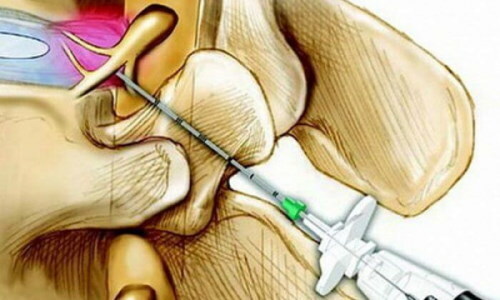
- injection or rubbing of non-steroidal anti-inflammatory drugs (NSAIDs);
- taking muscle relaxants that reduce the tone of skeletal muscles.
Surgical treatment is used to compress the nerve endings and the spinal cord. The indications can be sensory and movement disorders, paralysis of the upper limbs.
An alternative method of therapy that replaces surgery may be high-frequency denervation of the facet joints and laser vaporization of disc herniation, which are performed percutaneously method. These are minimally invasive neurosurgical methods of therapy.
Physiotherapy for stress
Treatment is suitable if the pain is caused by fatigue or tightness in the neck muscles. In another way, the condition is called myofascial syndrome. Massage of the neck and shoulders with a deep study of trigger points helps to eliminate spasms.
Physical therapy includes several techniques that can be combined:
- magnetotherapy;
- electrophoresis;
- laser therapy;
- radiofrequency ablation of the occiput (the method is based on exposure to frequency current).
It is helpful to supplement the treatment with a 15 minute neck stretch daily.
Without treatment, pain usually goes away on its own after 2-3 days. If myofascial syndrome persists, the use of muscle relaxants is acceptable. These are prescription drugs, so you need to see your doctor to get an appointment.
In severe forms of the syndrome, therapeutic blockades are performed. The patient is given injections at the location of the trigger point. The injection contains an analgesic and drugs that restore cartilage and muscle tissue.
With osteochondrosis of the cervical spine
Osteochondrosis is a collective definition of a group of diseases that cause degenerative and dystrophic processes in the bone tissues of the spine. The disease cannot be completely cured, but the condition can be alleviated and remission can be achieved.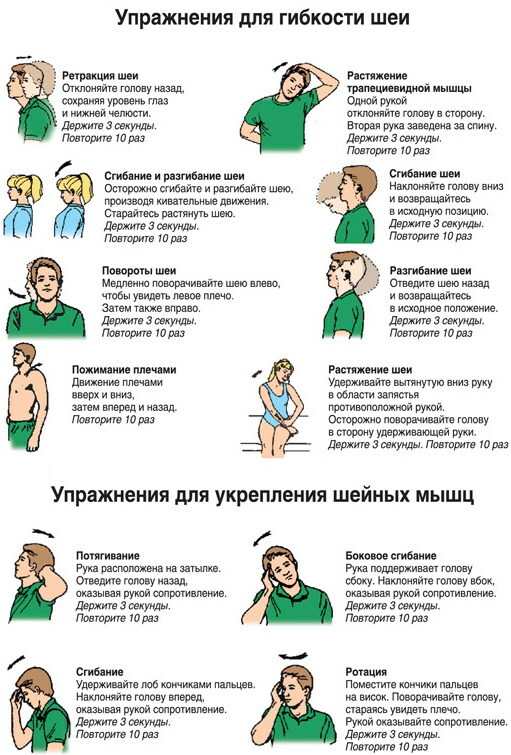
To eliminate pain in treatment, use:
- Exercise therapy (stretching and strengthening the neck muscles, stabilizing the upper spine);
- pain relievers (Pentalgin, Ketorolac);
- local funds from the NSAID group (Ibuprofen, Diclofenac);
- wearing a neck collar for 1 hour a day.
If an attack of pain has begun recently, you can apply a hot water bottle with ice to your neck for 15-20 minutes. After half an hour, you need to apply a warm heating pad to the same place. This will help prevent further development of pain. The method works in 80% of cases.
1-2 days after an exacerbation of osteochondrosis, you need to observe a rest regimen. You can not make sudden movements, physical activity should be avoided.
To identify the cause of pain in the neck and back of the head, a comprehensive diagnosis is needed. All pathologies, except for joint damage and pinched nerves, can be treated independently by performing light therapeutic exercises. If the warm-up does not help, and the pain persists for more than 2 days, you need to undergo an examination.
Neck Pain Video
Malysheva about neck pain:


